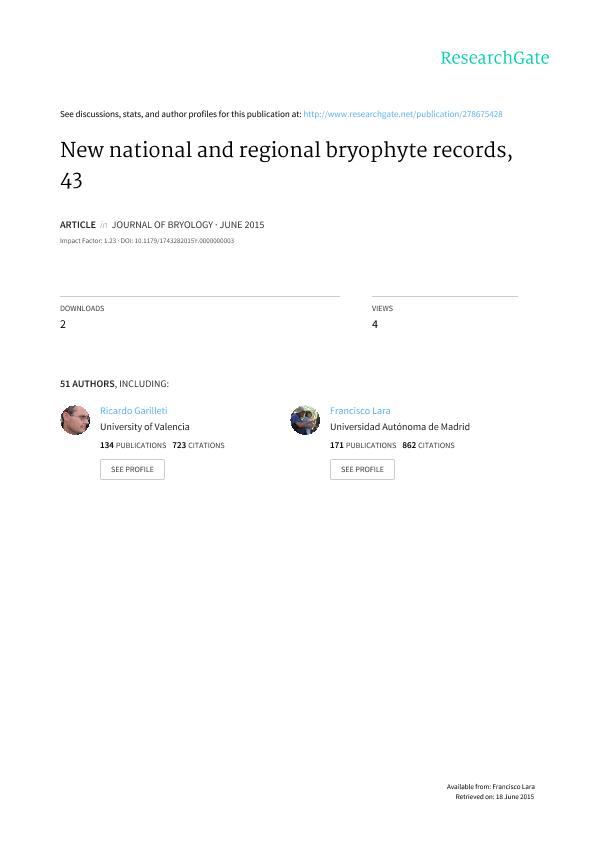Mostrar el registro sencillo del ítem
dc.contributor.author
Jimenez, Maria Soledad

dc.contributor.author
Suarez, Guillermo Martin

dc.contributor.author
Larrain, J.
dc.date.available
2016-09-22T21:37:44Z
dc.date.issued
2015-05
dc.identifier.citation
Jimenez, Maria Soledad; Suarez, Guillermo Martin; Larrain, J.; New national and regional bryophyte records, 43; Maney Publishing; Journal Of Bryology; 37; 2; 5-2015; 128-146
dc.identifier.issn
0373-6687
dc.identifier.uri
http://hdl.handle.net/11336/7685
dc.description.abstract
During the examination of a collection made by the authors in 2009 in San Pedro de Atacama (Antofagasta Region, Chile) one specimen was identified as Bryum incacorralis Herzog, a moss not previously known from Chile (Müller, 2009) and easily confused with some species of Philonotis Brid. (Ochi, 1980). Comparison with the type material confirmed its identity (Holotype: Bolivia, Cochabamba: an Felsen der ?Estradillas? bei Incacorral, 3000 m, Herzog s.n., JE! no. 04003475). Bryum incacorralis was first described by Herzog (1909) based on material collected in Cochabamba (Bolivia), and later recorded by Griffin (1977) and O?Shea (2010) from Venezuela. It is placed in the so-called sect. ?Alpiniformia? within the genus Bryum which is characterized by the presence of ovate to ovate-lanceolate leaf shape, the costa ceasing just below the leaf apex, the very dense areolation of the leaf, and long, more or less clavate capsules (Ochi, 1980). This note constitute the first record of Bryum incacorralis from Chile, where the species was found in the highlands of the north part of the country, in San Pedro de Atacama, an arid high plateau placed at the east of Antofagasta, growing on soil between Laretia, at ca. 4000 m. Bryum incacorralis is a distinctive species characterized by small to medium sized plants, scarcely lustrous, with ovate-lanceolate leaves, not or hardily bordered, equally spaced through the stem, with an acuminate apex and an abruptly narrowed base; laminal cells hexagonal to short-rectangular, and a costa ceasing just below the apex. Chilean specimen is synoicous, with antheridia and archegonia mixed at the same gametoecium, with abundant filiform paraphyses longer than the sexual structures. In comparison with the type specimen, the Chilean sample is more robust, its leaves margin are little revolute, and the apex vary from mild to markedly abruptly acuminate, sometimes ending in a small mucro.
dc.format
application/pdf
dc.language.iso
eng
dc.publisher
Maney Publishing

dc.rights
info:eu-repo/semantics/openAccess
dc.rights.uri
https://creativecommons.org/licenses/by-nc-sa/2.5/ar/
dc.subject
Bryaceae
dc.subject
Chile
dc.subject
Alpiniformia
dc.subject.classification
Ciencias de las Plantas, Botánica

dc.subject.classification
Ciencias Biológicas

dc.subject.classification
CIENCIAS NATURALES Y EXACTAS

dc.title
New national and regional bryophyte records, 43
dc.type
info:eu-repo/semantics/article
dc.type
info:ar-repo/semantics/artículo
dc.type
info:eu-repo/semantics/publishedVersion
dc.date.updated
2016-09-19T19:31:34Z
dc.journal.volume
37
dc.journal.number
2
dc.journal.pagination
128-146
dc.journal.pais
Reino Unido

dc.journal.ciudad
London
dc.description.fil
Fil: Jimenez, Maria Soledad. Consejo Nacional de Investigaciones Científicas y Técnicas. Centro Científico Tecnológico Nordeste. Instituto de Botánica del Nordeste (i); Argentina
dc.description.fil
Fil: Suarez, Guillermo Martin. Universidad Nacional de Tucumán. Facultad de Ciencias Naturales E Instituto Miguel Lillo; Argentina. Consejo Nacional de Investigaciones Científicas y Técnicas; Argentina
dc.description.fil
Fil: Larrain, J.. The Field Museum; Estados Unidos
dc.journal.title
Journal Of Bryology

dc.relation.alternativeid
info:eu-repo/semantics/altIdentifier/url/http://www.tandfonline.com/doi/full/10.1179/1743282015Y.0000000003
dc.relation.alternativeid
info:eu-repo/semantics/altIdentifier/doi/http://dx.doi.org/10.1179/1743282015Y.0000000003
Archivos asociados
